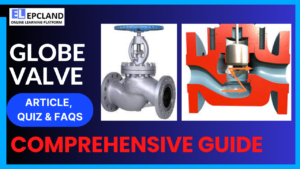1. Land preparation of Pipelines
Why is securing landowner consent essential before Land preparation of Pipelines activities?
Explanation: Securing landowner consent is essential to comply with legal requirements and ensure a cooperative relationship, allowing for a smooth pipeline construction process.
2. Topsoil Stripping
Why is topsoil stripped and stockpiled during onshore pipeline construction?
Explanation: Topsoil is stripped and stockpiled for later use in restoring the land to its original condition after pipeline construction. It is rich in organic matter and supports plant growth.
3. Trench Excavation
What factors influence the depth and width of the trench during onshore pipeline construction?
Explanation: The depth and width of the trench during onshore pipeline construction depend on factors such as pipe diameter, burial depth requirements, and soil conditions.
4. Pipe Stringing
What does the process of pipe stringing involve during onshore pipeline construction?
Explanation: Pipe stringing involves aligning, lifting, and placing pipe sections along the designated route using specialized equipment.
5. Backfilling and Topsoil Replacement
What occurs after the pipeline is laid and tested during onshore pipeline construction?
Explanation: After laying and testing the pipeline, the trench is backfilled with excavated soil, and the stockpiled topsoil is replaced to restore the land’s original profile.
6. Terrain Survey
What method is employed for surveying the seafloor during offshore pipeline construction?
Explanation: Side-scan sonar, a high-frequency sound system, is employed to survey the seafloor during offshore pipeline construction.
7. Pipeline Crossings
What is installed to protect both pipelines and prevent damage during offshore pipeline crossings?
Explanation: Specially designed mattresses or bridges are installed during offshore pipeline crossings to protect both pipelines and prevent damage.
Short Article on Land preparation of Pipelines
Land preparation, excavation, and pipe stringing are crucial steps in the construction of both onshore and offshore pipelines. These processes ensure that the pipeline is laid safely and securely, minimizing environmental impact and maximizing operational longevity.
Land preparation of Pipelines: Onshore Pipeline
1. Landowner Consent and Working Corridor Preparation:
Prior to any land preparation activities, securing landowner consent is essential. Once consent is obtained, the working corridor, a temporary workspace along the pipeline route, is prepared. This involves clearing vegetation, removing debris, and grading the terrain to provide access for construction equipment.
2. Topsoil Stripping:
Topsoil, the fertile upper layer of soil, is stripped and stockpiled for later use in restoring the land to its original condition. This layer is rich in organic matter and crucial for supporting plant growth.
3. Trench Excavation:
The trench, a ditch in which the pipeline will be laid, is excavated using excavators or trenchers. The depth and width of the trench depend on the pipe diameter, burial depth requirements, and soil conditions.
4. Pipe Stringing:
Pipe sections are transported to the trench site and laid end to end along the designated route. This process involves aligning, lifting, and placing the pipe sections using specialized equipment.
5. Backfilling and Topsoil Replacement:
Once the pipeline is laid and tested, the trench is backfilled with excavated soil. The stockpiled topsoil is then replaced, restoring the land’s original profile and facilitating revegetation.
Land preparation of Pipelines: Offshore Pipeline
1. Terrain Survey:
Side-scan sonar, a high-frequency sound system, is employed to survey the seafloor, mapping surface soil types, outcrops, boulders, and holes. This information is crucial for planning the pipeline route and identifying potential hazards.
2. Route Preparation:
The pipeline route is prepared by presweeping sand waves, which are underwater sand dunes, to create a smooth surface for laying the pipeline. Debris, such as rocks and wreckage, is removed using dredgers.
3. Pipeline Crossings:
When offshore pipelines cross existing pipelines or other underwater structures, specially designed mattresses or bridges are installed to protect both pipelines and prevent damage. Mattresses are typically made of heavy-duty plastic or concrete filled with sand, while bridges provide structural support for the crossing pipes.
Table of Contents
Don’t miss the Course on Effective Isometrics Management: Check Now
Enrollment Link
Recommended courses (Published on EPCLand)
- Complete Course on Piping Engineering
- Basics of Piping Engineering
- Piping Layout Engineering
- Piping Material Engineering
- Piping Stress Analysis
- Material Requisitions
- Piping Material Specifications
- Valve Material Specifications
- Plant Design & Layouts-OISD 118
- Isometric Management
Library of Technical Articles
Don’t miss out the collection of 15+ articles on following topics:
- Basics of Oil and Gas Industry
- Valves
- Testing
- Tank
- Piping Bulk Items
- Pipe
- Metallurgy
- Piping Materials
- Layout
- Instrumentation
- Heat Exchanger
- Type of Contracts
- Codes and Standards
- ASTM Standards
- Articles on Piping Specialty Items
Video details of Complete Course on Piping Engineering
Why Enroll in the EPCLand
Proven Track Record– PTR
Activities & Achievements before launching EPCLand
- Published more than 50+ short courses
- 3000+ Enrolments
- More than 3,500,00 Minutes of watch hours in the last 2 years
- 4000+ Students in 100+ Countries
- Rating of 4+ out of 5
- 1000+ YouTube Videos
- 8K+ Subscribers
What Students will Learn
- Codes & Standards of the Energy Sector
- Piping Material Engineering
- Piping Layout Engineering
- Stress Analysis
Interesting facts
- All the published courses have been developed by Industry Experts with more than 2 decades of experience
- Content is based on Practical experience and real-time problems.
- Content is designed and organized in such a manner that it can be easily grabbed.
- Complete website, Blogs and Quiz sections are Planned, Designed and published by myself (About me: Atul Singla)
- Complete flexibility of Time & Location, Students can access the content from anywhere & anytime
- Moreover, once enrolled, the content can be access as many times as you want, which helps in understand the fundamentals in a better way.
Conclusion
In conclusion, our courses are meticulously crafted by industry experts with over two decades of hands-on experience. The content is rooted in practical knowledge, addressing real-time problems. The material is thoughtfully designed and organized for easy comprehension. Every aspect, from the website to blogs and quizzes, has been planned, designed, and executed by Atul Singla, ensuring a comprehensive and seamless learning experience. With the flexibility of accessing the content at any time and from any location, students have the freedom to learn on their terms. Furthermore, enrollment grants unlimited access, allowing learners to revisit the material as often as needed, fostering a deep understanding of the fundamentals.



